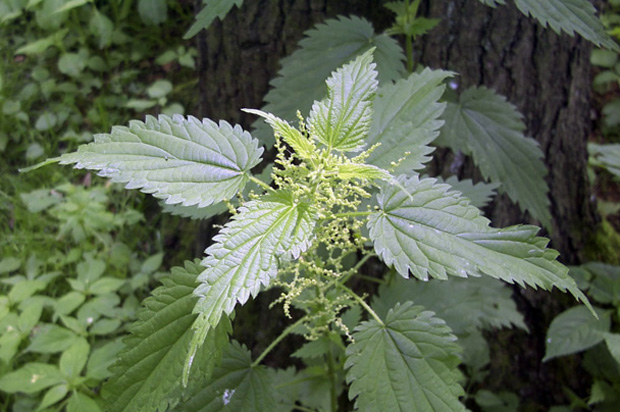You’ve likely heard of a cure being worse than the ailment. That’s the case with an herb known as stinging nettle which in the past was sometimes applied to insect bites or muscle soreness as a cure; in the dreadful pain that ensued from the sharp little barbs located on the leaves and stem of the nettle, the victim forgot all about the original pain. In fact, in ancient times in a practise known as urtication, paralysed limbs were bombarded with bunches of stinging nettles in hopes of restoring feeling.
Stinging nettle is one of those curious plants that, on the one hand been thought of as a wretched nuisance by gardeners, and quite terrifying to hikers walking through meadows, and on the other hand, as an herb with an abundance of curative properties. In times past, all parts of the plant (leaves, stems and roots) were used for various ailments.
One thing is sure – stinging nettle comes by its name honestly. The underside of the heart-shaped leaves and stem of the plant are covered with small hollow hairs which act like hypodermic needles when people or animals brush it, actually injecting a stinging venom into the skin which can cause a red itchy swelling. The ironic thing is that an extract produced from the nettle can relieve rash brought on by touching the nettle in the first place! While this has not been totally explained by researchers, it seems nettle has antihistamine properties which relieve inflammation. So-called nettle rash can also be caused by allergies to foods such as eggs, wheat or seafood as well as reactions to fungal spores or insect bites.
Rubbed into the scalp
As with many other herbs that have a long-time reputation as a curative, folk medicine is mixed in with fact based on credible research. For example, in the past, fresh nettle juice was rubbed into the scalp to make the hair grow, a custom that may have its roots in the belief that plants show characteristics that give clues to medicinal virtues (i.e. think hairy leaves). While the sting from the nettle may, indeed, make hair stand on end, research does not support the theory that nettle juice encourages hair growth.
However there is some evidence for other medicinal cures. As has been noted that nettle has antihistamine properties and thus has been used to relieve sneezing and itching in people with hay fever and asthma. Capsules containing nettles (often freeze-dried) were used in a study that concluded that nettle reduced the body’s production of histamine in response to an allergen. Herbalists suggest those troubled with hay fever take a freeze-dried preparation of stinging nettle well before the season begins.
Stinging nettle root is also used in Europe to treat benign prostatic hyperplasia (BPH), a condition that shows itself in reduced urinary flow, incomplete emptying of the bladder and a constant need to urinate. Caused by the enlarged prostate gland pressing against the urethra, it is believed nettle root contains chemicals that affect hormones in the body that act directly on prostate cells. While BPH is not dangerous in itself (although inconvenient), it should be monitored by a physician in case it develops into something more serious.
Involving human subjects
These two ailments have been relieved by stinging nettle as shown by studies involving human subjects, and are backed up by laboratory tests. This is not to say that the herb may not have other medicinal uses – as used in the past – such as providing relief for arthritis, sore muscles and digestive tract issues such as acid reflux, bloating and colitis. It has also been shown to lower blood pressure, act as a diuretic and raise blood sugar levels. That means that it could interfere with medication you are taking for hypertension, diabetes or heart and thus shows the importance of consulting your physician before deciding to self-treat.
The safest way to explore stinging nettle – perhaps as a test to relive hay fever – is to drink it in the form of tea, available in health food stores. The dried leaves form a tasty drink, but may also be used to make poultices and salves if you wish to try it on sore muscles.
I would not recommend growing stinging nettle in the garden. On the other hand why not? I think this may be the answer to keeping rabbits away from my spinach!




